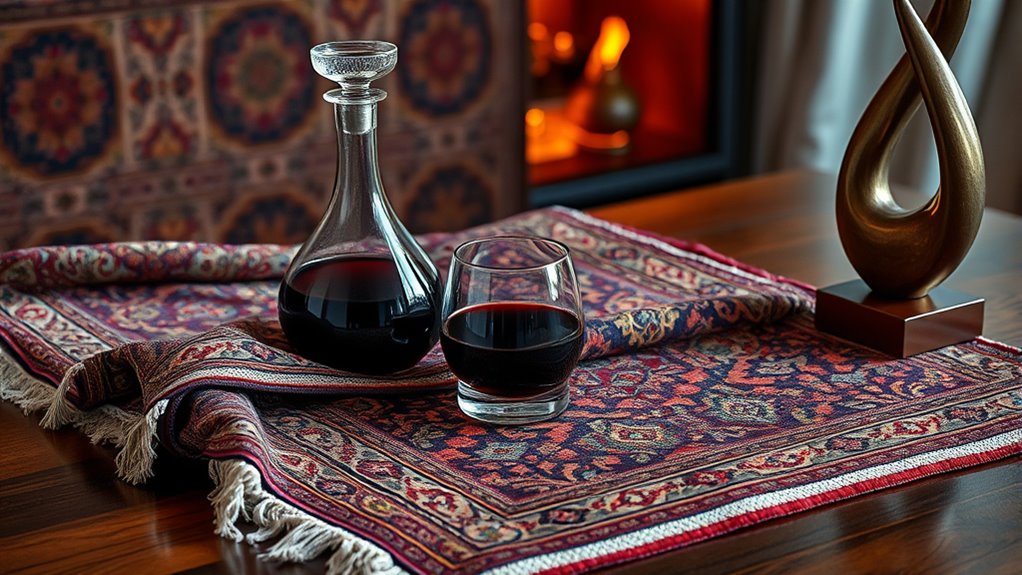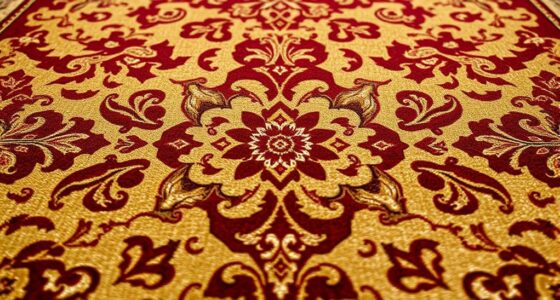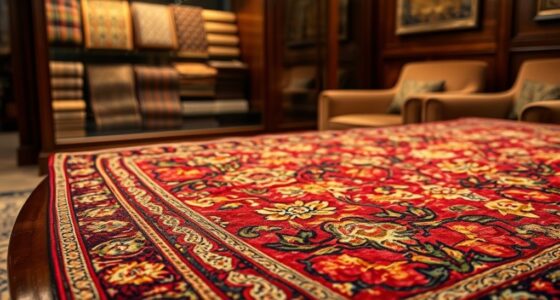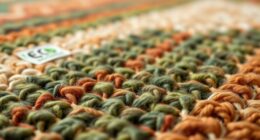To build a cross‑investment portfolio with art, rugs, and wine, first understand each asset’s market value, trends, and unique factors like provenance and rarity. Assess your goals and risk tolerance to choose a balanced mix that offers growth and diversification. Focus on authenticity, proper storage, and security to preserve quality. Stay attentive to market signals, and carefully time your investments. If you want to learn more about creating a resilient, profitable collection, keep exploring these strategies.
Key Takeaways
- Diversify your portfolio by combining art, rugs, and wine to balance risk and enhance potential returns.
- Assess each asset’s value, provenance, and market trends to ensure authentic, high-quality investments.
- Align asset choices with your investment goals, risk tolerance, and ethical considerations for a personalized strategy.
- Implement proper storage, maintenance, and security measures to preserve asset condition and protect your investments.
- Monitor market signals and trends regularly to optimize timing, asset allocation, and long-term portfolio performance.
Understanding the Value and Market Dynamics of Art, Rugs, and Wine
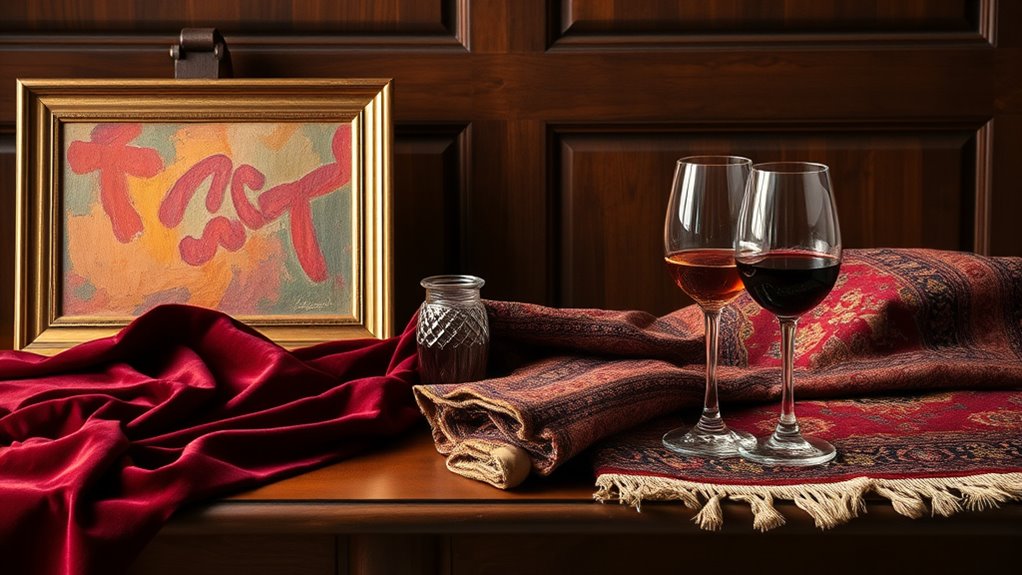
Understanding the value and market dynamics of art, rugs, and wine is essential for building a diversified cross-investment portfolio. Market valuation plays a pivotal role, as it determines the current worth and potential for appreciation over time. You should also consider the cultural significance of each asset, which influences demand and desirability among collectors and investors. Art, rugs, and wine often carry historical or cultural stories that add to their prestige and value. Recognizing trends within these markets helps you identify when to buy or sell. Additionally, understanding factors like provenance, rarity, and condition can markedly impact market valuation. These factors are often influenced by market trends and collector preferences, which evolve over time. Developing leadership skills can help you navigate complex market assessments and make informed decisions that balance risk and reward in your diversified portfolio. Being aware of psychological factors such as buyer behavior and market psychology can also improve your ability to anticipate shifts and capitalize on emerging opportunities. Furthermore, understanding personality traits of different investors can provide insight into market dynamics and decision-making processes. Building awareness of emotional influences can help you maintain a disciplined approach in volatile markets and avoid impulsive investments.
Assessing Your Investment Goals and Risk Tolerance
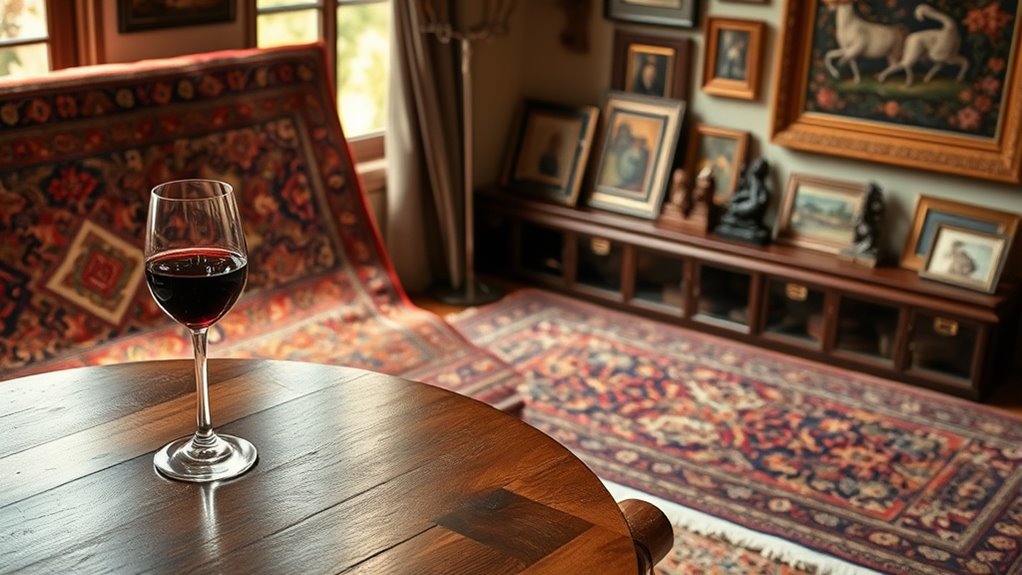
Before you start building a cross‑investment portfolio, it’s essential to assess your investment goals and risk tolerance. Think about what you want to achieve and how much emotional investment you’re willing to make. Consider these key points:
- Your target returns, like the appreciation of art or the resale value of wine
- How comfortable you are with market fluctuations and potential losses
- Liquidity considerations—how quickly you can sell your assets when needed
- The emotional impact of holding unique investments, such as rugs or rare wines
- Being aware of family photoshoot fails that can occur unexpectedly and influence your perception of value or investment stability. Additionally, understanding drivetrain maintenance and gear-shifting techniques can help preserve your assets and ensure smooth performance over time. Recognizing the horsepower of electric dirt bikes can also inform your decisions if considering investments in related technology or equipment. Incorporating space optimization strategies from home improvement can also assist in organizing and safeguarding physical assets within your investment collection. Also, considering the nutritional value in baked kale may inspire you to diversify your portfolio with health-conscious or sustainable assets.
Curating a Diversified Selection of Art, Rugs, and Wine
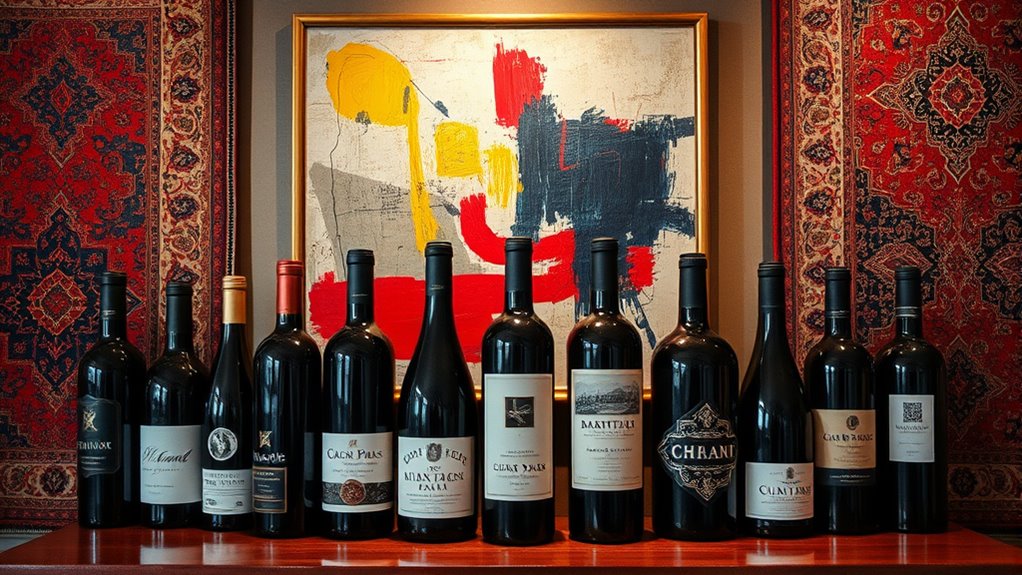
Once you’ve clarified your investment goals and assessed your risk tolerance, the next step is to curate a diverse collection of assets like art, rugs, and wine. Focus on balancing emerging artists’ works with vintage collections to diversify your portfolio. Emerging artists offer growth potential and freshness, while vintage collections provide stability and historical value. When selecting art, pay attention to provenance and market trends. For rugs, consider rare vintage pieces versus contemporary designs. With wine, diversify between well-known vintages and rare bottles from rising regions. Use this table to guide your choices:
| Asset Type | Focus Area | Key Considerations |
|---|---|---|
| Art | Emerging artists | Market trends, provenance |
| Rugs | Vintage collections | Rarity, condition |
| Wine | Rare vintages | Region reputation, storage |
| Art | Contemporary works | Artist reputation |
| Wine | Investment-grade wines | Provenance, aging potential |
Additionally, understanding market trends can help you identify promising opportunities and avoid potential pitfalls. Being aware of performance metrics can further assist in evaluating the success of your investments over time. Moreover, keeping abreast of market fluctuations can help you adjust your portfolio proactively, especially when considering self-watering plant pots as a metaphor for maintaining steady investment growth.
Strategies for Authenticity, Provenance, and Quality Assurance

Ensuring the authenticity, provenance, and quality of your investments is essential to building a reliable and valuable cross-asset portfolio. Authenticity Verification confirms you’re acquiring genuine pieces, whether it’s a rare painting or a vintage wine. Provenance Documentation traces the item’s history, establishing trust and value. To safeguard your assets, consider these strategies: 1. Request detailed certificates of authenticity from reputable sources. 2. Cross-check provenance records with established databases or experts. 3. Examine physical markers—labels, signatures, or unique features—that verify authenticity. 4. Regularly update documentation to maintain an accurate provenance trail. Additionally, consulting vetted sources ensures your information remains trustworthy and up-to-date.
Managing Storage, Maintenance, and Security Concerns
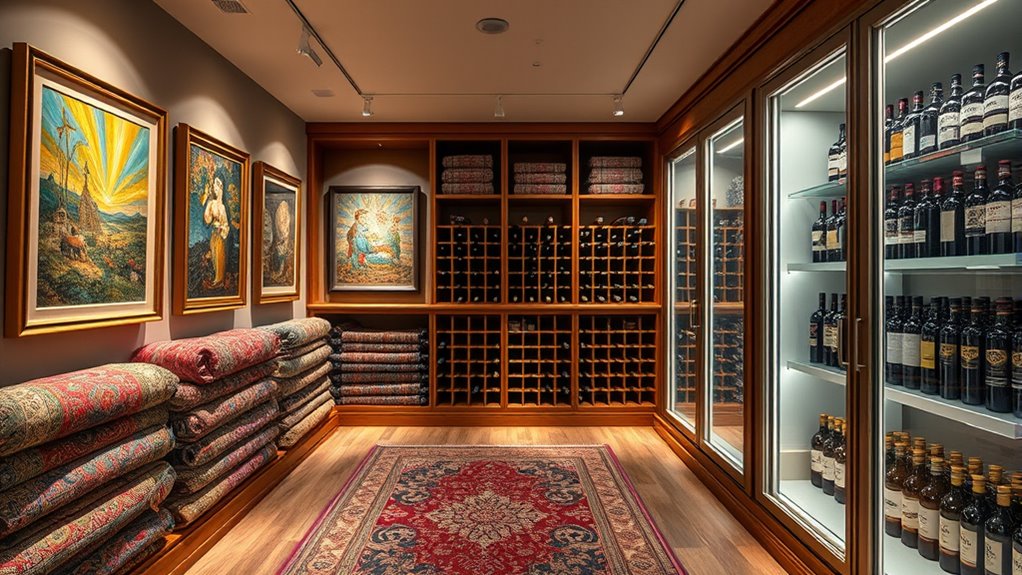
Effective management of storage, maintenance, and security is crucial to preserving the value and integrity of your cross-asset investments. Proper climate control helps prevent deterioration caused by humidity, temperature fluctuations, or pests, especially for art, rugs, and wine. Regular maintenance ensures your assets stay in excellent condition, reducing the risk of damage. Security measures like surveillance systems, alarm systems, and controlled access protect your investments from theft or vandalism. Additionally, all-encompassing insurance coverage is essential; it provides financial protection against loss, damage, or theft. Understanding espionage techniques can inform better security practices for safeguarding valuable assets. Incorporating mindfulness strategies into your security routines can help maintain focus and vigilance, further enhancing your protection efforts. For example, staying informed about asset vulnerabilities can help you implement more effective protective measures. By carefully managing these aspects, you safeguard your assets’ worth over time, ensuring your investment portfolio remains resilient and well-preserved. Proper storage, maintenance, and security are the foundation of a successful cross-asset collection.
Monitoring Market Trends and Timing Your Investments
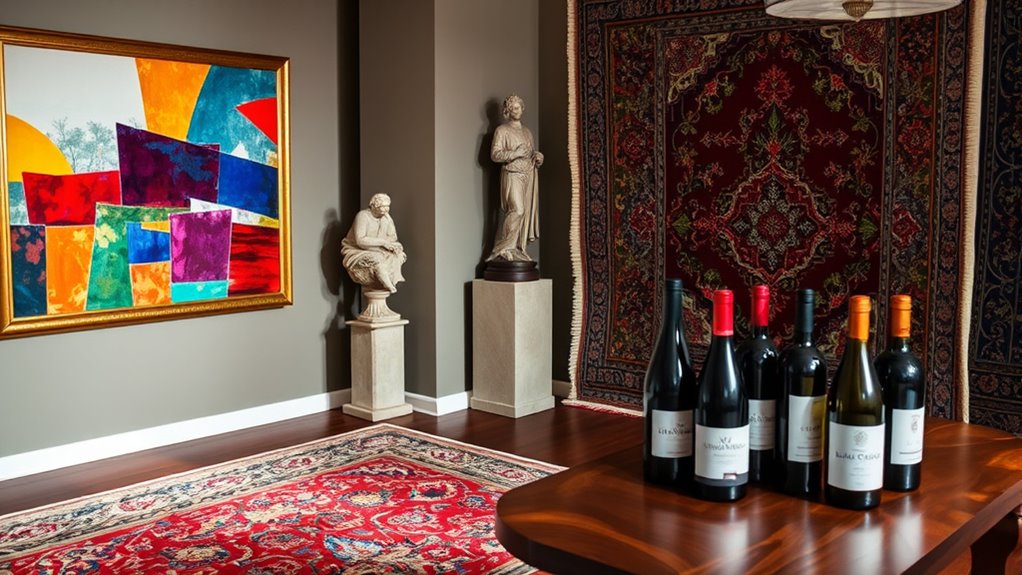
Keeping your investments secure is just the start; staying ahead requires actively monitoring market trends and understanding when to make your move. Market volatility can shift quickly, so you need to recognize key signals. Envision this:
- Watching for sudden price swings that signal an entry or exit point
- Analyzing economic indicators that hint at upcoming shifts
- Tracking auction results or sales data for art and rugs to gauge demand
- Staying alert to wine market fluctuations that suggest ideal buying or selling times
Combining Assets for Optimal Portfolio Performance

Combining different asset classes allows you to create a more resilient and balanced portfolio. By diversifying art, rugs, and wine investments, you reduce risk and improve potential returns. Consider how tax implications affect each asset; some may offer favorable treatment or defer taxes, influencing your overall strategy. Ethical considerations also come into play—investing in pieces that align with your values can enhance satisfaction and reputation. Balancing these assets involves understanding their unique performance drivers and how they interact under various market conditions. This approach helps you manage volatility and achieve a more stable, long-term growth. Remember, thoughtful asset combination isn’t just about maximizing gains but also about aligning investments with your financial goals and personal principles.
Frequently Asked Questions
How Do Taxation Policies Affect Cross‑Asset Investment Gains?
Taxation policies substantially influence your investment strategies and gains. Tax implications determine how much you keep from profits on different assets, like art, rugs, or wine. Some assets might have favorable tax treatment, encouraging diversification, while others could face higher taxes, reducing returns. Understanding these policies helps you optimize your cross-asset investments, minimizing tax burdens and maximizing gains. Always consider current regulations to craft effective strategies and protect your investments’ growth.
What Are the Legal Considerations for International Art, Rug, and Wine Transactions?
Imagine you’re buying a rare Picasso across borders; you must navigate international trade laws and guarantee proper documentation. Legal considerations include complying with customs regulations, verifying ownership rights, and respecting intellectual property laws. These issues are crucial in international trade, preventing fraud and theft. You should also understand export/import restrictions, taxes, and cultural heritage laws to avoid legal pitfalls when trading art, rugs, or wine globally.
How Can Technology Enhance the Management of a Diverse Investment Portfolio?
Technology can substantially enhance your portfolio management by enabling digital tracking of all your investments, providing real-time updates and insights. It helps you monitor performance across diverse assets like art, rugs, and wine, making portfolio diversification easier and more strategic. With advanced tools, you can identify trends, rebalance efficiently, and minimize risks, ensuring your investments remain aligned with your financial goals. Embracing technology ultimately makes managing a varied portfolio more efficient and informed.
What Are the Ethical Concerns Associated With Art, Rug, and Wine Investments?
Addressing ethical concerns, you must consider authenticity verification, ensuring art, rugs, and wine aren’t falsely fabricated or fraudulently marketed. You should also be mindful of cultural appropriation, respecting origins and cultural significance. These issues highlight the importance of honest handling, ethical sourcing, and respecting traditions. By prioritizing transparency and cultural sensitivity, you can promote integrity while investing wisely in diverse, valuable assets.
How Does Cultural Significance Impact the Valuation and Desirability of Collectibles?
Cultural significance greatly influences how you value collectibles, as cultural narratives shape their importance and appeal. When you recognize a piece’s symbolic value within a community or tradition, it enhances its desirability and perceived worth. This cultural context adds depth, making collectibles more than just material assets. You’ll find that items rooted in meaningful stories or traditions often command higher prices, reflecting their integral role in cultural identity.
Conclusion
By understanding market dynamics, evaluating your goals, curating your collection, and managing authenticity, storage, and timing, you create a balanced, thriving portfolio. You diversify your assets, strengthen your knowledge, and sharpen your strategy. You monitor trends, adapt your approach, and optimize your investments. Ultimately, you build a cross-investment portfolio that’s resilient, rewarding, and reflective of your passions and priorities—because when you stay informed, you stay empowered, and your investments flourish.
